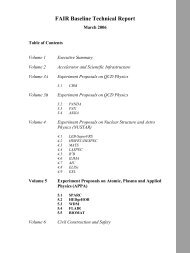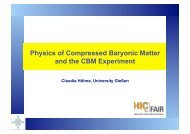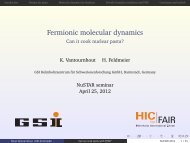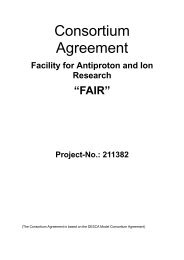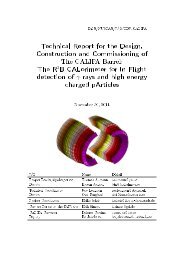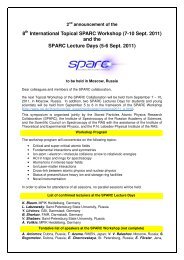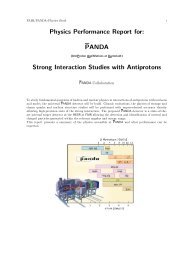NeuLAND - FAIR
NeuLAND - FAIR
NeuLAND - FAIR
You also want an ePaper? Increase the reach of your titles
YUMPU automatically turns print PDFs into web optimized ePapers that Google loves.
In the following section we discuss the <strong>NeuLAND</strong> performance along some of the physics<br />
examples, as laid out in chapter 2. However, to summarize the overall relative energy<br />
resolution σ(Erel), we display in figure 4.17 σ(Erel) as a function of Erel, exemplarily for<br />
132 Sn decaying into 131 Sn and one neutron at beam energies of 600 AMeV, derived from<br />
phase-space simulations.<br />
Figure 4.17.: The relative energy resolution σ(Erel) for Erel values from 100 to 3000 keV<br />
is shown for 132 Sn decaying into 131 Sn and one neutron at beam energies of<br />
600 AMeV. The values, derived from phase-space simulations, are displayed<br />
for distances between the detector and the target of 15.5 m (squares) and<br />
35 m (circles). The resolution is proportional to the square-root of Erel,<br />
the curves present fit functions with a proportionality to √ Erel.<br />
4.5.4. Physics Cases<br />
Evolution of the Collective Response of Exotic Nuclei<br />
For the investigation of heavy exotic nuclei with respect to their collective response, we<br />
discuss, exemplarily, the case of 136 Sn, excited in inverse kinematics via the Coulomb<br />
interaction. The input distribution of dipole strength takes into account a giant dipole<br />
resonance (GDR) and additional strength at lower energy, resembling the pygmy dipole<br />
resonance (PDR). For the GDR, a peak energy of Em = 15.5 MeV and a resonance<br />
width of Γ = 4 MeV were adopted as resonance parameters from systematics. The<br />
GDR exhausts 100% Thomas-Reiche-Kuhn (TRK) sum rule strength. For the PDR,<br />
59





